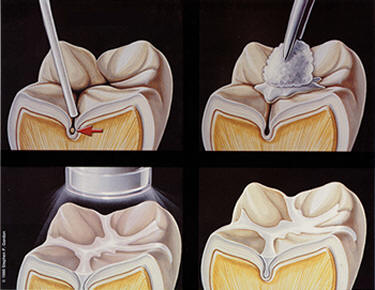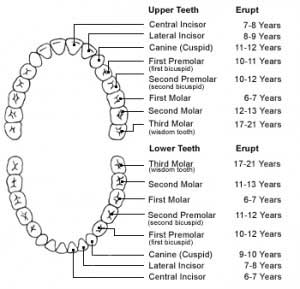Boy, I sure wish they had dental sealants for teeth back when I was a kid!
When new teeth erupt into the mouth for the very first time they are exposed to all kinds of things in the modern American diet that want to melt them away. Every little groove, pit and fissure on the tooth can accumulate food and bacterial plaque causing a chronic acid bath that can eventually result in a cavity. A thin plastic or glass ionomer material called dental sealants can be placed inside these places on the tooth to fill in the potential trouble spots before they can become decayed.
Dental sealants were first reported in studies in the mid-1950s, but were not widely introduced to dental offices until 1967, and recognized by the American Dental Association until 1971. Since then they have become very common in practically every dental office throughout the world.
I believe in dental sealants so much that I even sealed my children’s baby teeth! Generally, sealants are placed on the permanent teeth when the tooth first erupts to about two years post eruption. The research shows that this is the most vulnerable time in the tooth’s life.
Sealants are a fairly simple procedure usually delegated to either the dental hygienist or dental assistant in the State of Florida. The surface of the tooth is first cleaned with either a brush or a spray of baking soda as in our office. This cleans the bacteria and food out of the pits/grooves very effectively. Then a mild acid wash conditions the tooth structure to accept the sealing material, just like a bonded filling. A very thin light sensitive plastic or glass ionomer material is placed inside the pits/grooves and cured with a very bright light.

Insurance Caution:
Most dental “insurance” companies will pay for dental sealants as part of the regular dental care coverage, BUT recently many companies have sought to cut back on sealant expenditures by placing unreasonable time limits on when sealants can be placed for each individual tooth. If you decide to not get sealants right after the tooth erupts into the mouth for personal or financial reasons, then you may be in danger of being refused coverage when you finally get around to sealing the teeth because of a dental insurance “trick” you were not aware of on your policy. It is up to you to contact your insurance representative and make sure your policy doesn’t have these ridiculous restrictions written into your contract.
References:
1. Tex Dent J. 2011 Feb;128(2):201-5. The American Dental Association’s Center for Evidence-Based Dentistry: a critical resource for 21st century dental practice. Frantsve-Hawley J, Jeske A. ADA Center for Evidence-Based Dentistry, USA.
2. Am J Public Health. 2001 Nov;91(11):1877-81. Treatment outcomes and costs of dental sealants among children enrolled in Medicaid. Weintraub JA, Stearns SC, Rozier RG, Huang CC. Department of Preventive and Restorative Dental Sciences, School of Dentistry, University of California, San Francisco 94118-1361, USA. janew@itsa.ucsf.edu
3. J Public Health Dent. 2007 Fall;67(4):191-8. Four-year cost-utility analyses of sealed and nonsealed first permanent molars in Iowa Medicaid-enrolled children. Bhuridej P, Kuthy RA, Flach SD, Heller KE, Dawson DV, Kanellis MJ, Damiano PC. Department of Community Dentistry, Faculty of Dentistry, Chulalongkorn University, Bangkok, Thailand.
4. Eur J Paediatr Dent. 2011 Mar;12(1):43-9. Clinical decision on pit and fissure sealing according to the occlusal morphology. A descriptive study. Courson F, Velly AM, Droz D, Lupi-Pégurier L, Muller-Bolla M. Department of Biomaterials, Faculty of Odontology Paris Descartes, France. frederic.courson@parisdescartes.fr
5. J Evid Based Dent Pract. 2011 Mar;11(1):14-7. Application of sealants through school-based sealant programs decreases dental caries prevalence. Chalmers NI. Department of Pediatric Dentistry, University of Maryland Dental School, 650 West Baltimore Street, 2nd Floor, Baltimore, Maryland 21201.
6. Am J Dent. 2010 Dec;23(6):311-6. Efficacy of a pit and fissure sealant in arresting dentin non-cavitated caries: a 1-year follow-up, randomized, single-blind, controlled clinical trial. Borges BC, Campos GB, da Silveira AD, de Lima KC, Pinheiro IV. Department of Dentistry, Federal University of Rio Grande do Norte (UFRN), Natal/RN, Brazil. boniek.castillo@gmail.com
7. BMC Public Health. 2011 Feb 14;11:100. Prevalence of sealants in relation to dental caries on the permanent molars of 12 and 15-year-old Greek adolescents. A national pathfinder survey. Oulis CJ, Berdouses ED, Mamai-Homata E, Polychronopoulou A. Associate Professor, Department of Paediatric Dentistry Dental School, University of Athens, Athens, Greece. cjoulis@paedoclinic.gr.
8. J Am Dent Assoc. 2011 Feb;142(2):184-93. The effect of an antibacterial monomer on the antibacterial activity and mechanical properties of a pit-and-fissure sealant. Li F, Li F, Wu D, Ma S, Gao J, Li Y, Xiao Y, Chen J. Department of Prosthodontics, School of Stomatology, Fourth Military Medical University, Xi’an, China.
9. Community Dent Oral Epidemiol. 2010 Dec 29. doi: 10.1111/j.1600-0528.2010.00599.x. [Epub ahead of print] Language and literacy relate to lack of children’s dental sealant use. Mejia GC, Weintraub JA, Cheng NF, Grossman W, Han PZ, Phipps KR, Gansky SA. Preventive and Restorative Dental Sciences, Division of Oral Epidemiology and Dental Public Health, University of California, San Francisco, CA, USA Australian Research Centre for Population Oral Health, School of Dentistry, The University of Adelaide, South Australia Center for Oral Health, Oakland, CA, USA Association of State and Territorial Dental Directors, Morro Bay, CA, USA.
10. Oral Health Prev Dent. 2010;8(4):351-9. Use of caries-preventive agents in children: findings from the dental practice-based research network. Riley JL, Richman JS, Rindal DB, Fellows JL, Qvist V, Gilbert GH, Gordan VV; Dental PBRN Collaborative Group. Department of Community Dentistry and Behavioral Science, University of Florida, Gainesville, FL, USA.
11. Am J Dent. 2002 Dec;15(6):407-11. Microleakage and wall adaptation of conservative restorations. Guelmann M, Bonnin S, Primosch RE, Söderholm KJ. Department of Pediatric Dentistry, College of Dentistry, University of Florida, Health Science Center, Gainesville, FL 32610-0426, USA. mguelmann@dental.ufl.edu
12. J Am Dent Assoc. 2001 Oct;132(10):1442-51; quiz 1461. Sealant use and placement techniques among pediatric dentists. Primosch RE, Barr ES. Department of Pediatric Dentistry, University of Florida, Gainesville, USA.
13. J Okla Dent Assoc. 1979 Fall;70(2):11-6. Occlusal sealants–a neglected procedure for dental caries prevention in children. Primosch RE.

